143 Search Results for tabi
October 3, 2016
by Carole Zangari -
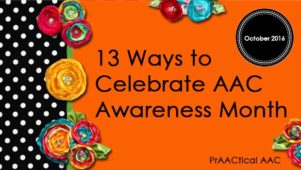
Need some ideas for celebrating AAC Awareness Month? Here are a few to get you started. Participate on the #USSAAC Twitterchat on 10/13 at 7:00 pm EDT (UTC−04:00). New to Twitterchats? You can learn more here. The wonderful Chris Bugaj will be moderating. Subscribe to a blog with an AAC content, such as Uncommon Sense, Jane Farrall Consulting, AAC Girls, or Superpower Speech Follow a new AAC topical Pinterest board from Lauren Enders and others: AAC and AT, AT/AAC/Adapt/Modify/Accessibility/Accommodations, AT for Communication, SLP AAC, & AugComm, AAC by Constantly Speaking, Communication-AAC Print, hang, or give someone an AAC awareness image, 10 Commandments of AAC Devices, or 5 Tips for Communicating with Nonverbal Student Register for a free AAC professional development webinar from Ablenet University Print out an AAC Poster, like Lauren Enders’ AAC Boot Camp-Getting AAC Users to Communicate or Kate Ahern’s The Periodic Table of AAC, Explore an AAC app or SGD that is new to you Print out song visual... [Read More...]
July 11, 2016
by Carole Zangari -
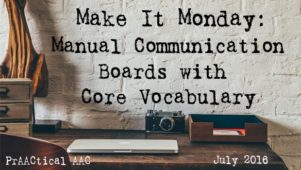
Welcome to Make It Monday, a series in which we hope to inspire your team to create communication boards and instructional materials for students who need or already use core vocabulary. In the first post, Getting Ready for a Core Vocabulary Journey, we talked about getting set up to make materials for expressive and receptive language use. Today, we get into making manual communication boards (MCBs). About Manual Communication Boards The term manual communication board refers to a ‘no-tech’ AAC support that students can use to express themselves. Typically printed on paper and laminated, most MCBs have grids of words organized by part of speech (e.g., verbs in one area, adjectives in another). MCBs that are designed for use in a particular activity, such as doing an art project or participating in Circle Time, are called activity-based communication displays, or ABCDs. ABCDs were very popular in the early days of... [Read More...]
May 19, 2016
by Carole Zangari -
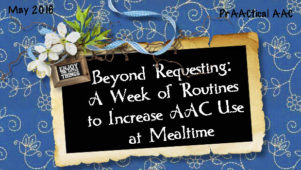
“Waffle.” “I want ___.” “More.” “I’d like a diet coke, please.” “Help.” Most AAC interventionists are quite effective at helping clients use their communication systems during snack or mealtime in order to make requests. How can we move beyond that and help AAC learners communicate for a wider variety of purposes? Mealtimes are wonderful social opportunities and we can take advantage of that by building interaction opportunities around predictable routines. Why build a routine? The predictability helps learners understand what is expected of them. Understanding the expectation sets the stage for active participation. When something becomes a routine, it gets implemented regularly. That gives our learners lots of opportunities to practice their new skills. It also gives us the opportunity to get better at key instructional strategies, such as aided language input, creating explicit opportunities, and using language expansions. Need some suggestions for routines that can be created to foster... [Read More...]
February 8, 2016
by Carole Zangari -
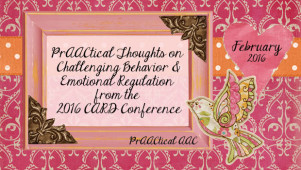
Last month, I had an opportunity to hear Dr. Barry Prizant, Director of Childhood Communication Services and Adjunct Professor at Brown University, at the 2016 Center for Autism and Related Disabilities Conference. Many of you know Dr. Prizant as co-author of SCERTS, the Social Communication Emotional Regulation Transactional Supports Program, and his recent book, Uniquely Human, discussed in this video. At this conference, he spoke on ‘An Emotional Regulation Approach to Preventing Problem Behavior.’ Here are some points of interest from his presentation. Dr. Prizant suggested that when someone is dysregulated, the first thing we should think about is biological factors that may be causing or exacerbating the problem. Why? Because unless we address the root of the problem, chances are slim that any behavioral, communicative, or psychological strategies will be effective in the long run. In some cases, there is a rather straightforward solution, such as teaching our client... [Read More...]
November 2, 2015
by Carole Zangari -
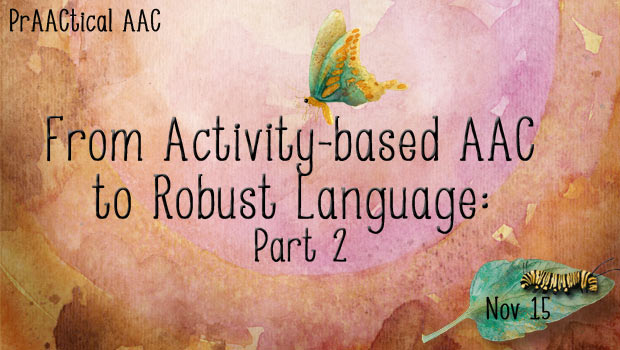
Last week, we talked a bit about activity-based communication displays (ABCDs), and the role they play for AAC learners. The analogy of feeding someone (with ABCDs) versus teaching them to fish for themselves (with robust AAC), resonated with many of you. In some cases, ABCDs can be a good way for therapists, educators, and families to take steps forward in their implementation of AAC. They allow students with little or no functional speech a way to participate in activities by making choices and comments, and that is a very good thing for those who don’t have a better option. There are a few drawbacks to ABCDs, though. Here are some of them. ABCDs limit language development. The learner can only experience the exact words and configurations that appear on a particular display. The learner has no way to expand his/her utterance by including other words or concepts. ABCDs are time-consuming... [Read More...]
September 10, 2015
by Carole Zangari -
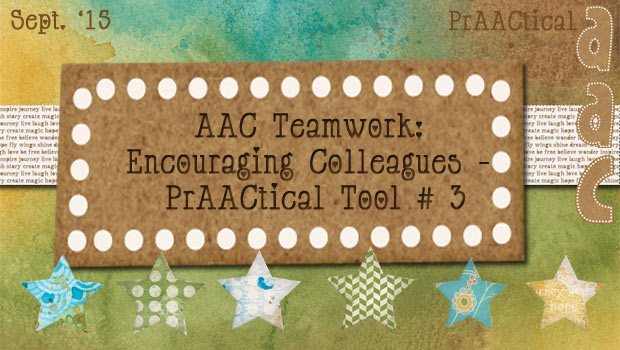
AAC is best played as a team sport. We’ve written about doing this with AAC inservice training, using AT throughout the school day, building classroom conversations, and other tools for using AAC in the classroom. No matter how you view it, AAC interventionists have to support one another. In this post, we continue our series of sharing printables that can be used to provide a little encouragement and recognition of our colleagues who are out there every day trying to do their best for AAC learners. You can download the bookmarks here, print and laminate them back-to-back, and share with with families, teachers, therapists, paraprofessionals, and others who are with you on this journey. And, if you missed the earlier printables, you can get those here and here.
August 27, 2015
by Carole Zangari -
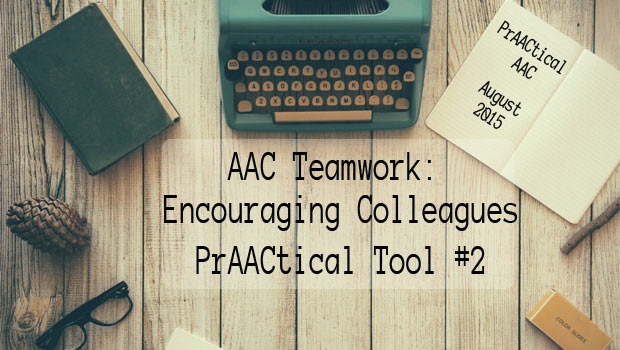
Even when everyone has good intentions, AAC implementation doesn’t happen overnight. Strengthening our resolve to learn the student’s AAC system, model it as we speak to them, provide instruction, and give ample opportunities for practice takes commitment and leadership. In the past, we’ve talked about strategies to get the team onboard with skills like aided language input, using no-tech communication boards to build language, and shared training materials. In this series, we’re sharing some printables to recognize the efforts of our team members, and keep them energized to keep going. Here is the second set of tags/bookmarks to share with your teams. You can download them here. If you missed the first set, you can get those here.
August 9, 2015
by Carole Zangari -
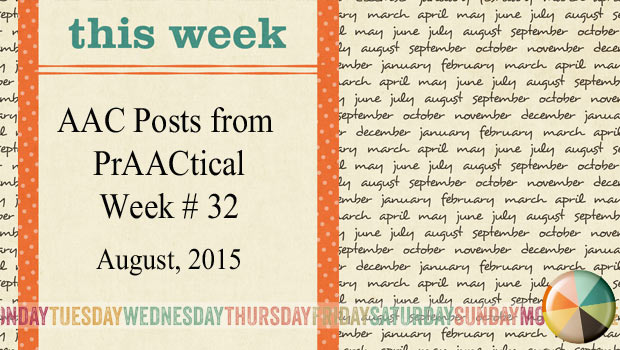
Monday – PrAACtically August: A Core Word Calendar Tuesday – AAC Therapy: When the Lesson Plan Fails Wednesday – Video of the Week: Building Engagement in Young Children with Autism Thursday – How I Do it: AAC Inservices by Tabi Jones-Wohleber
June 21, 2015
by Carole Zangari -
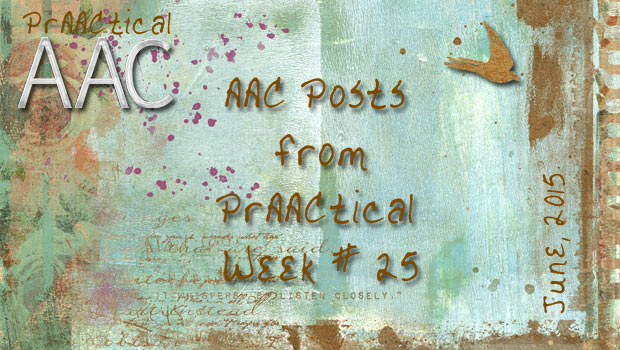
Monday – How I Do It: Classroom CORE Book by Tabi Jones-Wohleber Tuesday – “What’s Wrong?” AAC Messages for Negative Emotions and Feelings Wednesday – Video of the Week: Communication Through Eye Pointing Thursday – Site of the Month: Miami Dade County PreKindergarten Program for Children with Disabilities
May 17, 2015
by Carole Zangari -
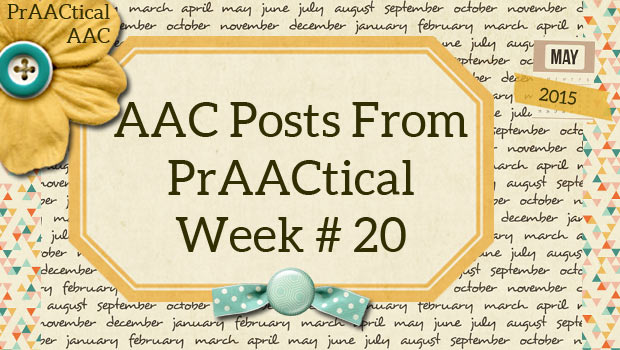
Monday – Sound/Music Cause and Effect Apps for Engaging AAC Learners Tuesday – Say What?!? AAC Assessment for Children Who Speak with Dr. Jill Senner and Matthew Baud Wednesday – Video of the Week: Communication Supports for Problem Behavior with Dr. Pat Mirenda Thursday – How I Do It: The All-in-One-Visual-Support Tool by Tabi Jones-Wohleber









